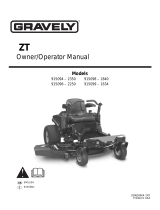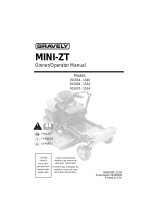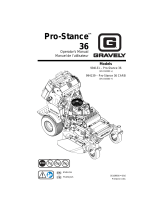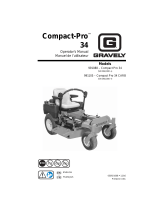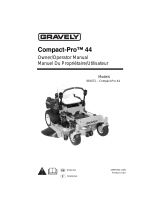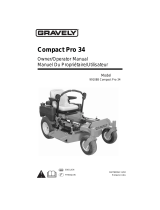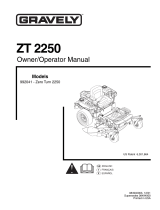
GB - 9
Disengage PTO when attachment is not in use. DO
NOT raise deck with blades running. ALWAYS turn off
power to attachment when travelling, crossing
driveways, etc.
Avoid uneven and rough terrain. DO NOT operate near
drop offs, ditches, or embankments. Unit can suddenly
turn over if a wheel is over the edge of a cliff or ditch, or
if an edge caves in.
DO NOT try to stabilize unit by putting foot on ground
when operating with applicable riding attachments.
When engine is running and speed control lever is
forward, holding only one steering lever will cause unit
to circle around one drive wheel.
Use care when approaching blind corners, shrubs,
trees or other objects that may obscure view.
ALWAYS disengage PTO, stop unit and engine,
remove key and allow moving parts to stop before
clearing clogs or cleaning unit.
Never leave a running unit unattended. ALWAYS shut
off engine before leaving unit.
ALWAYS remove key to prevent unauthorized use.
DO NOT operate in reverse unless absolutely
necessary. ALWAYS backup slowly. ALWAYS look
down and behind, before and while backing.
DO NOT operate on steep slopes. DO NOT operate on
slopes of more than 10°. Operate across the face of
slopes, not up and down.
Turf conditions can affect the unit’s stability.
Keep all movement on slopes slow and gradual. DO
NOT make sudden changes in speed or direction. Use
a slow speed to avoid stopping or shifting on slopes.
Avoid starting or stopping on a slope.
DO NOT park unit on a slope unless absolutely
necessary. When parking on a slope always chock or
block wheels.
Use extra care when loading or unloading unit onto
trailer or truck.
Secure unit chassis to transport vehicle. NEVER
secure from rods or linkages that could be damaged.
DO NOT transport machine while engine is running.
Keep unit free of grass, leaves, or other debris. Clean
up oil or fuel spills.
This product is equipped with an internal combustion
engine. DO NOT use on or near any unimproved, forest
covered or brush covered land unless the exhaust
system is equipped with a spark arrester meeting
applicable local, state or federal laws. A spark arrester,
if used, must be maintained in effective working order
by the operator.
Fuel is highly flammable and its vapors are explosive.
Handle with care. Use an approved fuel container.
No smoking, No sparks, No flames. ALWAYS allow
engine to cool before servicing.
NEVER fill fuel tank when engine is running or hot from
operation.
NEVER fill or drain fuel tank indoors.
Replace fuel cap securely and clean up spilled fuel.
Never fill containers inside a vehicle or on a truck or
trailer bed with a plastic liner. Always place containers
on the ground away from your vehicle before filling.
When practical, remove gas-powered equipment from
the truck or trailer and refuel it on the ground. If this is
not possible, then refuel such equipment on a trailer
with a portable container, rather than from a gasoline
dispenser nozzle.
Keep the nozzle in contact with the rim of the fuel tank
or container opening at all times until fueling is
complete. Do not use a nozzle lock-open device.
If fuel is spilled on clothing, change clothing
immediately.
NEVER store fuel inside where there is an open flame,
such as a water heater.
Avoid Electric Shock. Objects contacting both battery
terminals at the same time may result in injury and unit
damage. DO NOT reverse battery connections.
Reverse connections may result in sparks which can
cause serious injury. Always connect positive (+) lead
of charger to positive (+) terminal, and negative (-) lead
to negative (-) terminal.
ALWAYS disconnect negative (-) cable FIRST and
positive (+) cable SECOND. ALWAYS connect positive
(+) cable FIRST, and negative (-) cable SECOND.
Explosive Gases from battery can cause death or
serious injury. Poisonous battery fluid contains sulfuric
acid and its contact with skin, eyes or clothing can
cause severe chemical burns.
No flames, No sparks, No smoking near battery.
ALWAYS wear safety glasses and protective gear near
battery. Use insulated tools.
DO NOT TIP battery beyond a 45˚ angle in any
direction.
ALWAYS keep batteries out of reach of children.
Battery posts, terminals and related accessories
contain lead and lead compounds, chemicals known to
the State of California to cause cancer and
reproductive harm. Wash hands after handling.
Reverse connections may cause sparks which may
result in injury. ALWAYS connect/disconnect cables in
proper order.
Poisonous battery fluid contains sulfuric acid and its
contact with skin, eyes, or clothing can cause severe
burns.
Explosive Gases! No flames, No sparks, No smoking
near battery.
ALWAYS wear safety glasses and protective gear near
battery.




















